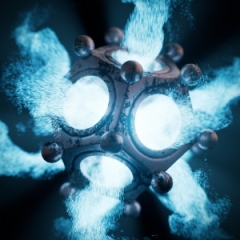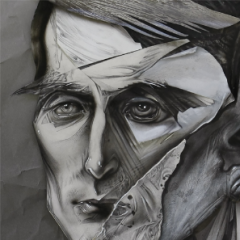All Activity
- Today
-
Found the solution! It's a bit unintuitive to set up, but works so far at least for a relatively simple setup like this. But, as I feared there is NO way to do this with the SDS intact. It just has to be converted. Maybe this is possible with scene nodes, but I don't know how those work so this is my solution for now. Convert your target and source mesh if it's an SDS. Click on the Phong Tag of each of them and press "Create Normal Tag". This will essentially "freeze" your Normals on the mesh in the current state, as the Normal Tag overrides the Phong Tag as long as it exists. Click on the Normal Tag on your target mesh and enable "Fields" in the "Transfer" menu. Switch to the "Fields" tab on the tag. You should see a "Freeze" layer. This layer is basically the current normals on your mesh as the Normal Tag saved it. Do not delete this, or you will lose all your normals and your mesh will appear black. Drag the Normal Tag from your source mesh into the fields list. You should see your normals change. Click on the "Variable Field Tag" layer you just created and switch to the "Layer" tab. Change "Mode" to "Average". This essentially takes your target normals and changes them so they are an average of all the source mesh normals that are within a specified radius. You can adjust how large this radius is with the "Radius" setting. You want this relatively low, so only a couple of points around your "transition area" are involved. You might not want a smooth transition either, depending on your usecase. In that case you can disable "Distance Falloff" This entire setup should look something like this: So what does this do? Essentially we are keeping our original normals (which is the "Freeze" layer) and are then overwriting the parts that we actually want via the "Variable Tag Field" layer. If this is set to anything other than "Average" it will not work as intended for this workflow. Averaging is exactly what we want here for a smooth transition. Now let's assume we only want ONE part of the mesh actually having this transition. For this we need to add a little more to the fields. We can, for example, add a polygon selection as a mask below the "Variable Tag Field" layer. Then a polygon selection like this: ... can mask out the transition to only happen at the base, not at the thin part: You can add another "Freeze" layer after all of this to "save" this setup and delete the source object, so you don't have to keep unnecessary objects in your scene. So yeah, this is a bit more involved than in Blender and unfortunately not at all as convenient and most importantly not as non-destructive as in Blender, but at least it's possible. Maybe something Maxon can work on in the future 😉 I think this should be part of the Normal Editing toolset with a couple of clicks instead of... this.
-
dasfrodo started following Transferring Normals between Meshes
-
So in Blender there is this very handy modifier called "Data Transfer" that makes it possible to dynamically transfer normals between different meshes. What would you need this for? Well, for example something like this: Meshes before transfer Meshes after transfer Note that these are EXACTLY the same meshes as before. It is not connected to the main body in any way, it's just the normals that were transferred for the row of points that touches the main body. Now in THEORY this is possible in C4D as well, in multiple ways, but I can't get it quite to work. I also tried exporting the mesh from Blender and importing it again in C4D, but that somehow breaks the shading and it doesn't look nearly as good as in Blender. Technique 1: VAMP Create Normal Tag on source mesh Open VAMP Set up Source and Target mesh, tick "Normals" and set "Space" to "Global" Press "Transfer Maps" This transfers the normals as expected, but I CANNOT decide what is transferred and what isn't. It looks like crap when ALL normals are transferred: And even IF you got that to look right: The Normal Tag breaks completely when you add a subdivision surface, so the only option would be to convert the SDS first, then do the normal transfer. This is significantly harder due to the amount of polygons involved though and kind of defeats the purpose of the parametric workflow in C4D. In Blender I could just put the SDS above the Data Transfer Modifier in the stack. Technique 2: Normal Editor This kind of works, but not really. As far as I can tell I can just adjust the normals of everything I selected in ONE direction. This works for the outer ring that touches the thick part of the model, but not for the part in front that wraps around the cylinder. The thick part just points in one direction, while the cylinder points in different directions. To add to that you have to somehow get the transitions between the normals to look great, which I just could not get to look right. And again, this breaks when SDS is involved, as the normals from the Normal Tag are ignored by the SDS. Technique 3: Transfer Attributes This is I think the best solution. You can transfer the normals between meshes via the attribute transfer function that is relatively new I think. The problem here is that I cannot seem to "mask" the transfer to only some points. It seems like the fields are acting as a value for the normals instead of being a mask for the value transfer. This is what I mean: It works JUST like the VAMP Normals transfer, just that it's "parametric" which is exactly what I want. But I cannot seem to restrict the transfer to only certain parts of the mesh. Also, of course, this breaks again when an SDS is involved, but I could at least have my normal transfer parametric after converting the SDS that way. If somebody could figure out how that works, if it's possible at all, that would be greatly appreciated 🙂 Stripped down Scene File is attached. Transfer.c4d
-
RTD joined the community
- Yesterday
-
Pikisekk joined the community
- Last week
-
Tanzil joined the community
-
Yes, there have been a few comments / reports about that. Apparently this is mainly an issue when a whole load of files were added to AB in last session, so you shouldn't see it every time hence, until you add some more. Furthermore if we find it is really irritating us, we can disable AI in the Asset Browser tab in Prefs. CBR
-
ParticleMan joined the community
-
Anyone else experiencing slow start ups with 2025.3.1? I manually added about 50 shaders from GSG Studio app into the Asset Browser yesterday over the course of a couple hours and it was so bad that I had to reboot because the system became unstable. After restarting C4D it still took about 3 hours of letting C4D process for it to be stable. When I rebooted today then loaded C4D I had a good 10 minute wait while it was doing "Speedup Asset Search" and "AI is analyzing assets". Should we not be using the Asset Browser for anything over a handful of extra assets since Maxon keeps loading their own "Maxon One" assets? Is this one of those cases where a feature was introduced but we shouldn't use it for a couple releases till it becomes stable? I'm referring to AI as I see there's a way to toggle it off.
-
Couple of animation tests on two of my characters using hair. Problem I seem to have on Witchy Peg is that even though I have added a collider to the head and hat, the hair still goes through them. Same with Hannah Bannah the hair goes through her face… Not sure why? Hannah Leap Test v01.mp4 Peg Gangnam HB v01.mp4
-
Oh, I see, you would need essentially double constraint, that looks quite difficult. Are the nulls always on mesh surface? Essentially transforming any null or mesh itself should transform whole setup, right?
-
HuQo joined the community
-
Charles joined the community
-
glenelg joined the community
-
Oleksa joined the community
-
josep joined the community
-
zeden started following C4D and Redshift June update.
-
Great work! Looks impressive considering the current state of the system.
-
Thanks Hrvoje, but that's unfortunately not what I'd like to have exactly. I know this kind of setup, with nested nulls. The problem is that one of the nulls does not "stick" with the mesh, and that is exactly what I want. Basically have nulls I can rotate / move the main mesh around with that always stay where they were in the beginning. After playing around a lot I don't think that is something that is really possible in a software like C4D with "tree" based scene management.
-
Great work, great effect! Thanks for sharing your impressions. I haven't had time to play around with the new water simulation in more detail yet. For now, I've noticed that in order to get the scale down to the real size of a glass, you have to change the simulation parameters a bit. Because on the default settings, when I get the particles down to 0.2 cm, the particles tend to go through the mesh. I haven't figured out how to set the simulation so that this doesn't happen at this scale yet, I'll come back to this in a month.
-
Wetmaps: I created a vertex map in field mode on the dinosaur and put the liquid mesher (with a bigger voxel size so it renders faster) into the field list. In the field settings, the mesher was set to volume, and I put a decay field on top with 100% so it stays wet where it has been touched by the mesher. I rendered the vertex map just as black/white mask, so I could use it in comp to darken the original render. Additionally, I rendered a seperate, very reflective pass of the dinosaur, that I added on top in comp, again using the wetmap as mask. trex_water_v007_Wetmap.mp4 I then comped everything together in Nuke. I tried to make a smooth transition between the simulated area around the dinosaur, and the rest of the lake, but that was a bit of a challenge and didn't work out to my full satisfaction...it's still noticeable that the simulation doesn't spread out to the rest of the lake. Some final thoughts: AFAIK, our liquids solver is an SPH solver, which is generally designed for small-scale fluids. FLIP would probably be better suited for fluids of that scale. I find it even more impressive that the new solver is capable of pulling this off. It's also very speedy and very stable. Fully art-directable as it works with all the forces, all other simulation types and all the particle modifiers. I enjoyed that little project.
-
Here are some insights from that little project: Easy things first. I reused the animation from my T. rex museum breakout: The environment is an HDRI from the asset browser. The lake (or river) is just a reflective plane with animated noise, and a gradient in the opacity channel to fade it softly into the backplate HDRI. The trickier part was the simulation, naturally. I wanted to simulate only the top layer of water, and I needed to figure out a way to only simulate particles in the area around the dinosaur. A whole lake would have been way too many particles of course. At first I tried to simulate it only in a "pool" that was a bit bigger than the T. rex, using the liquid fill emitter. It worked, but I had visible splashes at the border of the pool - unfortunate if you want the transition between simulation and the rest of the lake as seamless as possible. Instead of walls, I then gave the pool a slightly rising floor towards the edges. That helped mitigating the splashes at the border. However, I still had the problem that the liquid spreaded out pretty fast and drifted away from the dinosaur, where I actually wanted it to be. The beauty of the new liquids is that they work so seamlessly with the rest of the particles system: I could just use an attractor force in the center of the dinosaur. With the right settings, it helped keeping the particles near the T. rex, while still allowing it to act like a liquid. Here's the cached particles with the collider geo: trex_water_v007_Viewport.mp4 The sim contains 3.7 million particles. I used the liquid fill emitter with a radius of 0,7 cm. Sim time was IMHO very reasonable on my RTX 4090, around 20 mins for 150 frames. I would have liked to simulate even more particles, but when I lowered the radius to 0,6 cm (= 6 million particles), I didn't even see the first frame after waiting for several minutes, so I quit that. The cache is 27 GB. I only cached velocity, color and radius, which helped to reduce the size. I then used the liquid mesher with pretty much the default settings, but smaller influence scale, a lot more smoothing and the droplet size set to 10% - that really helps getting rid of those huge blobs that often appear. Here's a clay render, liquid mesh only: trex_water_v007_Clay.mp4 The particle color is mapped to the velocity, which was very handy to fake whitewater. I just remapped the particle color with a ramp to diffuse and reflection strength. The faster the particles, the brighter they are. I rendered them as a separate pass and added it on top in comp. Those particles render crazy fast! A few seconds per frame for 3,7 million particles with motion blur... that was a real joy. trex_water_v007_Whitewater.mp4
-
Here's a little project I made while I was betatesting the new liquids. trex_water_v006_high.mp4
-
dasfrodo started following Animating with multiple parents and Update on various DCCs and CG Technologies - (June 2025)
-

Update on various DCCs and CG Technologies - (June 2025)
dasfrodo replied to HappyPolygon's topic in News
I'm sure Autodesk will get no bad press at all for integrating AI character animation tools in their software that is known for having amazing character animation tools. This will surely go over well with the animators using this software. lol, I knew it: -
jonnyfive joined the community
- Earlier
-
Won't be of use, since this is a limitation that depends on the network setup. A file that doesn't work for me will work for you if you never have this problem. Years ago in another job we worked on network storage with C4D and it worked as well. Here, it doesn't, and according to support this is perfectly normal. I have never used this feature, but I'll have a look. I fear that I will not be able to use this due to IT guidelines etc. though 😛 Too much data, not to mention I have a library that needs to be synced all the time as well. Cloud storage is just not feasible with the amount of data and the internet speeds here.
-
This might be a really dumb question, but bear with me, please. Animation isn't something I have done a lot so far 🙂 Unfortunately I cannot seem to find a solution to this. Following scenario: I have an object that I want to animate. I want to animate this object via multiple helper nulls. Let's just assume I want to move and rotate this object around multiple axis, like in this image: Just to be clear, I do not want to rotate around both at the same time. I want it more like rotating around this axis at different times. This of course involves moving the null WITH the object while the other null is being animated. And this is where I hit a brick wall. Because this setup obviously leads to an infinite loops / circular dependency: This doesn't work at all, even if I turn down the "Weight" for Rotation Axis 2 while I animate 1, it just won't move with it. But it kinda makes sense. How can I solve this? Thanks!
-
Freeze Modifier Field doesn't work accross clones.
Hrvoje replied to Better Call Paul's topic in Cinema 4D
Can you please post a scene file? -
Better Call Paul started following Freeze Modifier Field doesn't work accross clones.
-
Hi, I was wondering if someone knows of a good workaround. I have a cube with 250 segments on X axis. I want to displace its top poligons using a Plain Effector as a child. In my Plain effector I have a Capsule field and underneath a Freeze modifier that's set to Grow. I want the capsule to touch the top of the cube and for the top poligons to move down in this wave like fashion. Cinema_4D_dN1I8atIjR.mp4 It works exactly how I want it on one cube, but I would like to clone the whole setup and if I do that, the Freeze field doesn't work anymore. I basically want to have a linear clone with these cubes next to each other and be able to drive the Capsule through the clones to trigger this wave animation. I would like to do this with a cube and only affect the top surface. I've tried various things like having this on a Matrix object and then using the matrix as a field (this way the plain effector isn't being cloned and the Freeze inside works as it should), but that gives me weird results. Also tried this with a spline in the same way, but also doesn't seem to produce good results. Is there a way to generate a cube from the Matrix object or spline? I tried Loft, but that didn't work either. Maybe there's an alternative to using Freeze? I might be really overthinking this... Would appreciate some tips. Thanks!
-
CORE4D Interviews - Hrvoje Srdelic - Resident C4D guru
Sikorsky replied to Corebot's topic in Interviews
Very nice, was not aware you are working for Maxon, that explains how you manage to know that much : ) -
petklik changed their profile photo
-
I think youtube did the job XD:
-
CORE4D Interviews - Hrvoje Srdelic - Resident C4D guru
Hrvoje replied to Corebot's topic in Interviews
Oh, I did not expect this to be available already 🙂 I am honored that I got the privilege to do the interview, thanks a lot to Rob @LLS That is a good test for AI 🙂 -
Hi, In 2025, NVIDIA deprecated the omniverse launcher. It's okay but they remove the actual installer. And I'm unable to open the Audio2Face without the GUI. Do you know any resource that has the old installer? If you google omniverse installer, you'll go to the entriprise version (?) of the installer. https://docs.omniverse.nvidia.com/launcher/latest/it-managed-launcher/install_guide_win.html#prerequisites-for-installation rathan than the straightforward old/single user version. or something like that.
-
awesome interview, especially the message for core4D. I agree, people definately need to interact, share and start things more(myself included). i will say though this interview is incomplete without this one final question: @Hrvoje how the hell do we pronounce your name!!!??? 😭 🤣




